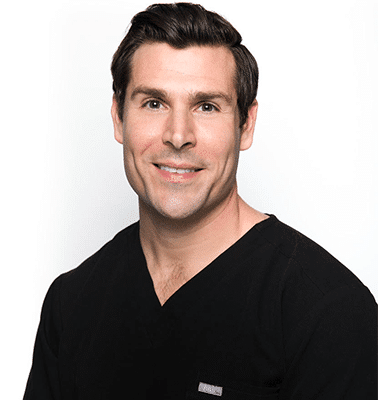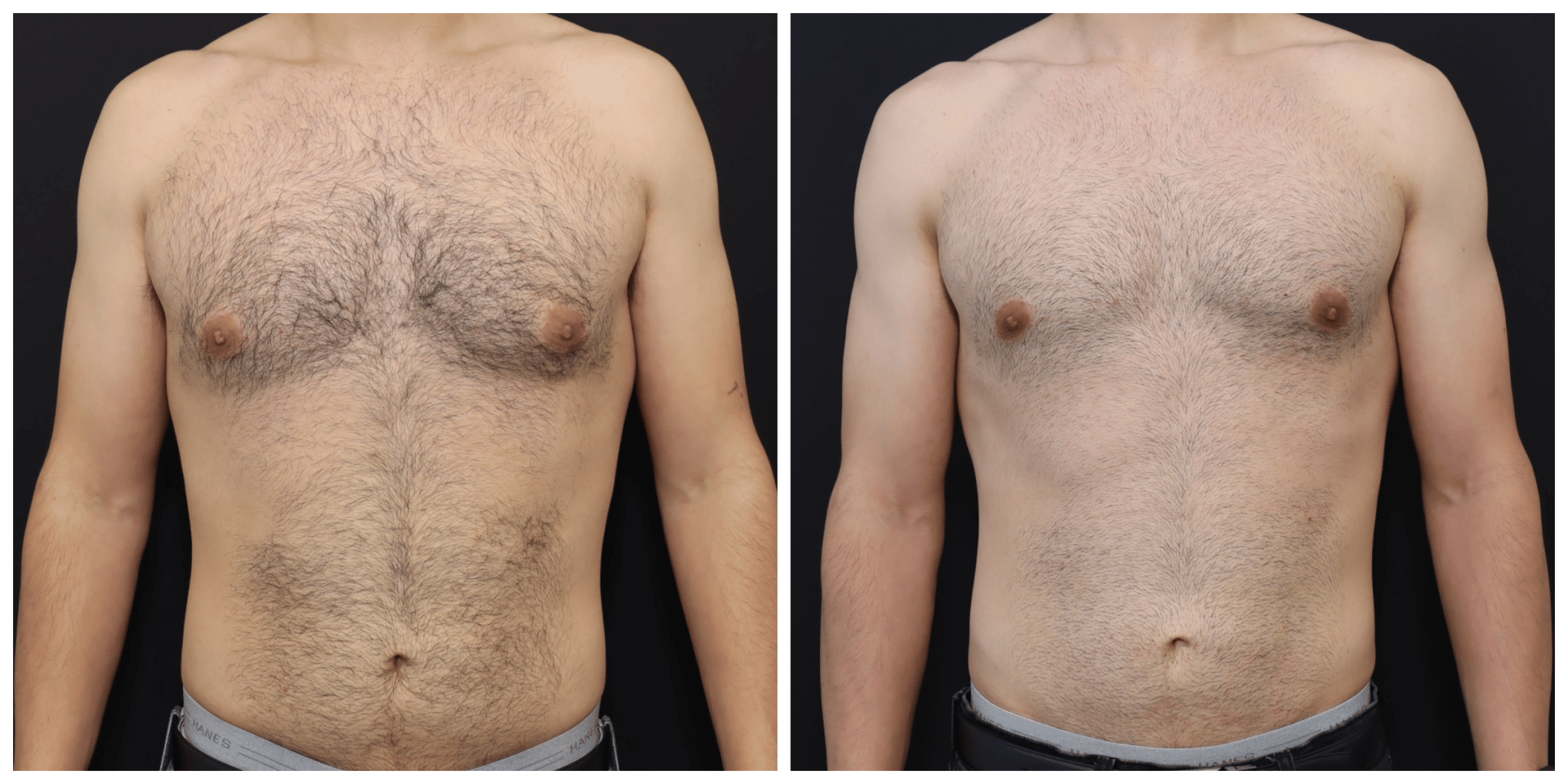Men
Gynecomastia San Francisco Bay Area
Gynecomastia or male breast reduction is the abnormal proliferation of male breast tissue. It is the most common male breast disorder, accounting for more than 65 percent of cases in the U.S.
Most men with gynecomastia seek treatment because of the stigma associated with having enlarged male breasts. This condition can worsen the quality of life for men who feel uncomfortable and self-conscious. Some men may find they avoid dating, going to the beach, or wearing certain kinds of clothing.
The condition can also be physically uncomfortable. It can cause pain and tenderness in the chest and may be accompanied by nipple discharge in some cases.
The good news is that you don’t have to live with gynecomastia. If you and your doctor have ruled out other possible medical conditions, and if you are in otherwise good physical health, gynecomastia surgery can be performed to inconspicuously remove the excess breast fat and tissue, leaving you with a flat, masculine chest that looks great and makes you feel like yourself again.
If you would like to eliminate gynecomastia from your life, Dr. David Sieber Plastic Surgeon San Francisco can help.
Meet David Sieber, M.D – Plastic Surgeon San Francisco

Dr. Sieber went on to become certified by the American Board of Plastic Surgery and has done thousands of Cosmetic and Reconstructive surgeries over the last 6 years of practice.
What Is Gynecomastia?
While it may be surprising to some, men have breast tissue just like women. Gynecomastia presents itself as an abundance of firm, fibrous breast tissue beneath the nipple. Redundant skin and an excess of fatty tissue are the hallmarks of this condition. It is relatively common in men of all ages. In fact, there are even celebrities with gynecomastia.
Men with gynecomastia are typically self-conscious about their appearance and are often frustrated by their inability to wear certain clothes like thin t-shirts. Thankfully, the condition is easily treatable with liposuction, and/or a surgical male breast reduction.*
Patient Testimonials
Dr. Sieber is a wonderful surgeon and person. He patiently explained the process of administering Botox and Filler, and how long it would last. As a male and it being my first time with these treatments, I felt very assured and comfortable right away with Dr. Sieber. Not only did the results turn out great, but the treatments lasted a long time! I am very pleased with the whole experience. I highly recommend him!
Matt W.
Being born and raised a male, my body developed into a wide chest, narrow hips like most typical men. After transitioning, I could not stand looking at my body. Seeing other women with their curvaceous bodies, I grew jealous, believing I could never have what they were born with. I finally had enough and began looking into operations that could me achieve what I wanted. I came across Dr. Sieber’s page and saw the numerous 5 stars review and figured why not setup an appointment with his office.
Arcya G.
Dr. Sieber is the real deal! This man knows his craft as any gifted artist does. His results speak for themselves, and to the passion and quality of care, Dr. Sieber has for his patients. Highly recommended.
Tyson Q.
What Causes Gynecomastia?
Any number of things can cause excess breast tissue or gynecomastia in men. These include age, hormones, genetics, and certain drugs/medications.
If you think you may have gynecomastia, it’s important to rule out underlying medical conditions, such as those related to hormones, first. Speak with your general practitioner or a plastic surgeon, and go over your medical history together. Talk about current or possible health issues. Sometimes, ceasing or changing certain medications or supplements can help improve gynecomastia.
Some gynecomastia is caused by hormones related to age. For example, teenage boys more experience this condition in puberty, but it generally goes away on its own as the young man grows up.
Gynecomastia vs Fat: How to Know if You Have It
Having extra fat in the chest is not exactly the same as having fibrous breast tissue in the chest. Some men may simply be genetically predisposed to carrying excess fat in the chest. Or, if you have a BMI on the higher side, you may have excess fat everywhere on your body, including the chest.
The fibrous tissue caused by true gynecomastia can happen to anyone, even the leanest, fittest men. The key difference is the presence of a hard, lumpy mass located directly beneath the nipple. The gynecomastia pinch test can help you determine whether your condition is caused by gynecomastia or excess fat alone.
The Gynecomastia Pinch Test
This simple test can be performed by a medical professional or you. To perform the test yourself, stand in the mirror without a shirt, and simply use your thumb and forefinger to gently palpate the area beneath the nipple.
You’re looking for a fibrous mass that is hard and lumpy. It may be the size of a walnut or bigger and will usually feel tender.
How to Get Rid of Gynecomastia
There are various methods used to correct gynecomastia. Most commonly, gynecomastia surgery is used. This may involve liposuction, excision of fibrous breast tissue, or a combination of both.
Many patients want to know how to get rid of gynecomastia with exercise or other non-surgical methods alone. While this is possible for those with gynecomastia that is related to having an overall high BMI, it’s simply not possible if you have fibrous tissue causing small lumps in your breasts. The latter usually requires surgery.
Those with only excess fat in the breast area, however, may certainly benefit from a gynecomastia treatment without surgery. Overall weight loss through healthy dieting and improved muscle tone through strength and cardiovascular training can do a lot to improve the appearance of some gynecomastia patients.
Lastly, it’s also important to find out the source of the issue when it comes to treatment. Some men will simply never know what caused their gynecomastia. But for others, locating a hormonal issue, a supplement or drug, or an underlying disease that is causing the gynecomastia can help to reverse the problem without the need for surgery.
Gynecomastia Surgery Technique
For liposuction to improve gynecomastia, Dr. Sieber will make one small incision under each breast through which he will administer a numbing agent that makes the fat easier to remove with a cannula. Removing the excess fat in the breasts is a simple way to deliver a flatter, more masculine contour to the chest.*
If fibrous glandular tissue is the main cause of your gynecomastia, again, Dr. Sieber will make a small incision at the lower edge of each areola through which he will remove the excess tissue. Once your natural chest contour has been achieved, the incisions will be closed with absorbable sutures.
In certain patients with very severe gynecomastia involving both extra skin and a large amount of fatty tissue, additional larger incisions may be needed. The location of these incisions will vary depending on your anatomy, but this will all be discussed with you in detail during your initial consultation.
Preparing for Surgery
As with any major plastic surgery for men, all medications and supplements which cause an increased risk of bleeding should be stopped 2 weeks prior to surgery. Please see our list of medications and supplements to avoid. As always, make sure to check with your doctor before stopping any medications.
Recovery
The results from surgery will be evident immediately afterwards.* Most patients do encounter some mild swelling for the first weeks to months after surgery. There will also be some swelling as well as discomfort around the incisions.
Compression garments are typically worn for up to three weeks after your procedure to help contour the chest, reduce fluid accumulation, and promote healing. Most of the swelling should be totally gone in between 3 and 6 months.* Regardless of the incision length, Dr. Sieber puts all of his patients on a scar therapy program after surgery to help you heal with the finest scars possible.*
Immediately after surgery, you will need to refrain from any serious physical activity for the first 2 weeks — at which point, you can return to light exercise. You may begin more intense exercise at 4 weeks. You will be released to full activities at 6 weeks post op.
How Much Does Gynecomastia Cost in San Francisco?
It’s crucial to note that this amount does not include essential fees such as your surgeon’s fee and anesthesiologist’s fee, nor does it include the cost of the surgical facility (or hospital) and other costs.
Patients must consider out-of-pocket gynecomastia costs as well, such as the cost of prescriptions or pre-surgery tests and scans (sometimes required). Furthermore, some patients will opt to purchase recovery supplies, such as additional compression garments.
Ultimately, these are the main factors that will influence the overall gynecomastia surgery cost you pay:
- Plastic surgeon’s fee: This amount often depends on the surgeon’s experience, training, and overall expertise.
- Anesthesiologist’s fee: Like plastic surgeons, anesthesiologists charge their own fees.
- Geographical location: In large cities where the cost of living is high, all medical procedures tend to cost more.
- Extent of the surgery: A patient who only needs a small amount of lipo will generally pay less than a patient who requires extensive lipo and the excision of fibrous tissue.
Frequently Asked Questions
View our before-and-after photo galleries to see the results our Male Breast Reduction for Gynecomastia patients have achieved.
How do I know if I have gynecomastia?
You can perform the gynecomastia pinch test. Use your thumb and forefinger to palpate the area beneath and around the nipple. Look for a hard lump around the size of a walnut that is located directly beneath the nipple.
How much is gynecomastia surgery in CA?
According to the American Society of Plastic Surgeons, around $4,250 is the average gynecomastia surgery cost. This does not include surgeon fees, anesthesiologist fees, or charges from medical facilities. Also remember that the gynecomastia treatment cost will vary depending on what type of surgery is required.
If I need gynecomastia surgery how much will insurance pay?
Many patients want to know how to get gynecomastia covered by insurance. This is a complicated matter that must be discussed with your provider. Not all providers cover this surgery, and many stipulations must be met by providers who do.
For example, your insurance company might want to know that you’ve had the condition for at least two years, that it causes you persistent pain and discomfort, that you’ve looked into other underlying conditions, that you’ve ceased taking any supplements or non-medical drugs, etc.
How long will my results last after surgery?
Because the fibrous and fatty tissue is being physically removed, you should experience lasting results as long as you’re able to maintain a normal body weight.*
How is gynecomastia treated?
Surgical gynecomastia treatment involves liposuction and/or excision of the fibrous breast tissue.
Is gynecomastia surgery high risk?
Surgery for gynecomastia is incredibly safe and most patients have recover quickly. As with any surgery and even with the greatest attention to safety on the part of the patient and surgeon, complications can occur.
What age is good for gyno surgery?
*Disclaimer: Results may vary from person to person. Editorial content, before and after images, and patient testimonials do not constitute a guarantee of specific results.










